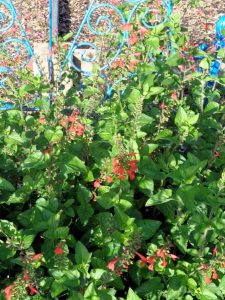
Some native plants do not have the “pizazz” that many of our more exotic plants possess. However, one native that does give a show is the tropical sage. Also called wild sage, fireweed, scarlet salvia, or scarlet sage, this relatively small, Florida-Friendly Landscaping™ plant, provides a beautiful red bloom that is not only ornamental, but also favored by butterflies and hummingbirds.
Growing about two feet tall and about two feet wide, this native perennial plant in the mint family grows upright into an almost vase-shaped form. Very small – under two-inch – slightly hairy, serrated leaves are attached opposite each other on the stem. The red flowers, one-inch long and tubular in shape, develop in a whorled pattern at the tip of the stems. The color plus the nectar load are a natural draw for hummingbirds, as well as butterflies and other various pollinators. Grown in patches for best dramatic effect, locate tropical sage in full sun sites in well-drained soil. Tropical sage is not salt-tolerant, so keep this plant away from saline conditions. Individual plants spaced about eighteen-inches apart, will quickly fill in a planting bed. Regular removal of old flowers will set the stage for an almost continuous bloom. In fact, plants that are getting a bit ragged can be cut back which will stimulate a new flush of growth and blooms. In addition to mass planting, tropical sage will do well in containers and as a border plant. Many volunteer plants will emerge from seeds produced over the year. These may get too crowded and require some thinning. In addition to seeds, the plants can be propagated by rooting cuttings.
One of the best things about plants in cultivation is the possibility of new cultivars. Tropical sage has produced several cultivars and many are now available commercially to gardeners. An improved cultivar called ‘Lady in Red’ was found to produce even more flowers of scarlet red. ‘Coral Nymph’ aka ‘Cherry Blossom’ has flowers of pink and white on noticeably compact plants. Two more compact cultivars are ‘Summer Jewel Pink ‘and ‘Summer Jewel Red’. An all-white type called ‘Snow Nymph’ is strikingly different and grows to two-feet tall.
You will not likely find this plant at many local garden centers. Family-run nurseries may have some, but also look for tropical sage at regional native plant nurseries. Tropical sage, and especially improved cultivars, are also readily available from on-line, mail order nurseries.
I really admire the tropical sage display at our Demonstration Garden on Harbor View Road. This is truly an easy plant to grow and enjoy for years to come! For more information on all types of easy-to-grow flowers, you can also call the Master Gardener Volunteer Helpdesk on Mondays, Wednesdays and Fridays from 1 to 4 pm at 764-4340 for gardening help and insight into their role as an Extension volunteer. Ralph E. Mitchell is the Director/Horticulture Agent for the UF/IFAS Extension Charlotte County. He can be reached at 941-764-4344 or ralph.mitchell@charlottecountyfl.gov.
Resources:
UF/IFAS Gardening Solutions (2022) Scarlet Salvia. The University of Florida Extension Services, IFAS.
The Florida-Friendly Landscaping™ Guide to Plant Selection & Landscape Design (2010) The University of Florida Extension Services, IFAS.
Gilman, G. F. (2014) Salvia coccinea Scarlet Salvia, Scarlet Sage. The University of Florida Extension Service, IFAS.
Mahr, S. (2022) Scarlet Sage, Salvia coccinea. The University of Wisconsin-Extension.
Bray, L. (2015) Tropical Sage, Salvia coccinea. Naples Botanical Garden.
Florida Wildflower Foundation, Inc. (2022) Tropical sage. https://www.flawildflowers.org/flower-friday-salvia-coccinea/
Source: UF/IFAS Pest Alert



